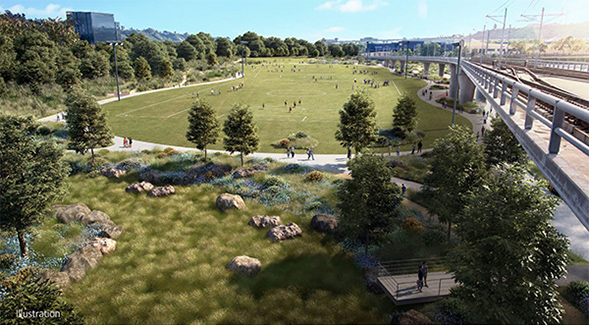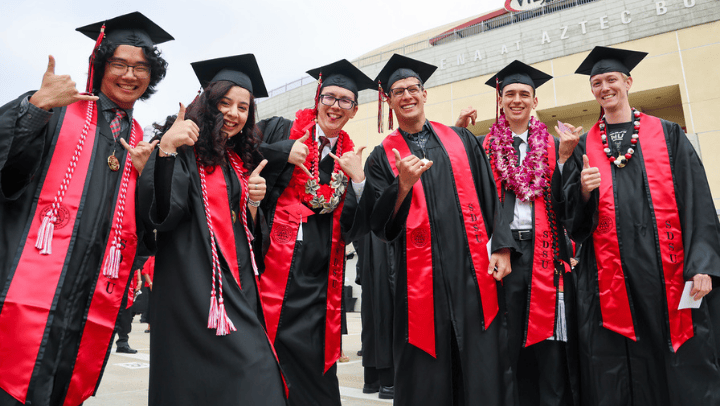SDSU Releases Mission Valley Site Final Environmental Impact Report (FEIR)
The FEIR includes information on the River Park, with enhanced traffic improvements and further reduces GHG emissions. The complete FEIR is available at missionvalley.sdsu.edu.

After receiving more than 175 comment letters and conducting several months of public outreach, including local planning groups, meetings of the River Park Advisory Group, stakeholder groups and individuals, SDSU has published its Final Environmental Impact Report (FEIR).
The document is now available on the SDSU Mission Valley website along with the public comment letters and detailed responses to each. The California State University (CSU) Board of Trustees will be considering the FEIR for certification at their meeting on January 28-29, 2020 in the Dumke Auditorium at the Office of the Chancellor in Long Beach, California.
Over the past several months, the SDSU Mission Valley team has continued to refine the project in response to comments.
“We thank all of those who took the time to learn more about our project and provide valuable input,” said SDSU President Adela de la Torre. “We’ve found creative ways to ensure our new campus is both environmentally sound and better connected to our existing campus and the surrounding communities.”
River Park
The River Park will be a destination for San Diegans from across the region. Accessible by trolley, biking and pedestrian pathways and trails, the River Park is a place where people of all ages can play and learn about the San Diego River environment and the region’s and site’s history.
The River Park and surrounding area include:
- Elimination of “Street I” adjacent to Murphy Canyon Creek, and realignment of Street H to more directly to connect Rancho Mission Road to the project. The road relocation will reduce constraints on wildlife, provide an enhanced passive park buffer along Murphy Canyon Creek, and better connect the River Park to surrounding neighborhoods
- Expanded trolley plaza to provide enhanced access to the River Park amenities, including bus service
- Educational platform overlooks providing viewing stations for the natural and riparian habitat within the passive park areas
Sustainability
Perhaps SDSU is most excited to showcase the many unseen but integral sustainability features of the project. While the Draft EIR committed to implementing numerous sustainability features, in response to comments received on the Draft EIR, additional commitments have been made that will further limit the site’s reliance on natural gas, electrify buildings and vehicles, increase recycling and increase photovoltaic energy generation, which in turn will reduce the project’s greenhouse gas emissions. Some of those changes include the following:
- The new stadium will be designed to be LEED Gold certified.
- All non-stadium buildings will require heating, ventilation and cooling systems (HVAC) and water heating systems to be electric, significantly limiting the use of natural gas throughout the project. Additionally, all fireplaces were eliminated from the residential units.
- In all Requests for Proposals for the Mission Valley campus, SDSU will include “Sustainability” as a component of the scoring criteria and weigh each builder’s commitment to implementing strategies above and beyond LEED Silver.
- ‘Purple pipe’ will be installed in all streets with landscaping and stubbed to all parks, recreation, and open space areas to allow for the future connection to a municipal reclaimed water system and used for irrigation purposes to reduce potable water usage.
Traffic Improvements
With regards to vehicle traffic, SDSU and the City of San Diego have agreed on numerous transportation improvements that will be implemented to reduce traffic impacts. These improvements include on-site improvements to be implemented as part of the project, as well as off-site mitigation improvements identified through the EIR process. In addition, over and above the project’s mitigation requirements, and as identified in the EIR, the project will provide an additional $5 million towards community benefit improvements that include:
- Adaptive signal technology along the Friars Road Corridor
- Upgraded signal and camera technology at the Ruffin Road/Aero Drive intersection
- Restriping Rio San Diego Drive to add new buffered bike lanes
- Adding a two-way left turn lane to Rancho Mission Road/Ward Road as well as one-way cycle tracks
To address questions about connectivity between the existing SDSU campus and the Mission Valley site, SDSU has committed to complete a “Campus to Campus bike path” by filling gaps to provide for a continuous bike lane/path between the campuses.
Additional clarifications have also been made related to impacts to Caltrans facilities and the CSU’s commitment to feasibly mitigate its fair share of impacts to these facilities.
Finally, as outlined in university’s offer letter, while not a part of or required by the master plan project EIR as a mitigation measure, SDSU has also committed to fund and construct the future Fenton Parkway Bridge as a separate proposed project in coordination with the City of San Diego.
Additional Project Refinements
The site plan has been revised to provide two additional residential pads in the southeast portion of the project site development area, and to convert former select service hotel site to a residential building. This allows the 4,600 residential units to be developed with or without high-rise construction in order to provide more affordable construction. The rooms planned for the former select service hotel site have been added to the full-service conference hotel site, which will remain a high-rise structure.
Additionally, in coordination with MTS, a third proposed alignment for the future “Purple Line” trolley is identified in the FEIR, and a potential transit center has been refined with at least four bus bays at the Stadium Trolley Station.
At the CSU Board of Trustees meeting later this month, the board will also consider the financing plan and authorization to execute the purchase of the Mission Valley stadium property from the City of San Diego. More information about the board item and information about how the public can attend will be made available at https://www2.calstate.edu/csu-system/board-of-trustees.
SDSU Releases Mission Valley Site Final Environmental Impact Report The FEIR includes information on the River Park, with enhanced traffic improvements and further reduces GHG emissions. (All photos: Schmidt Design Group)



